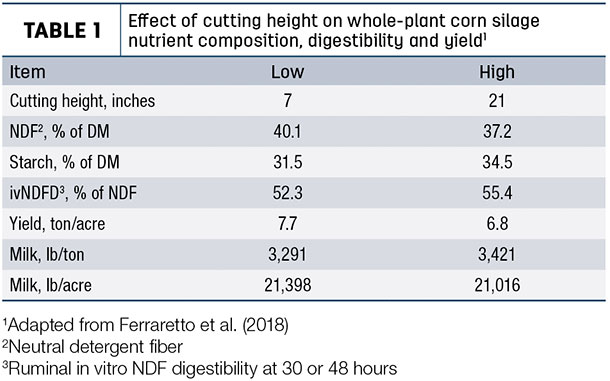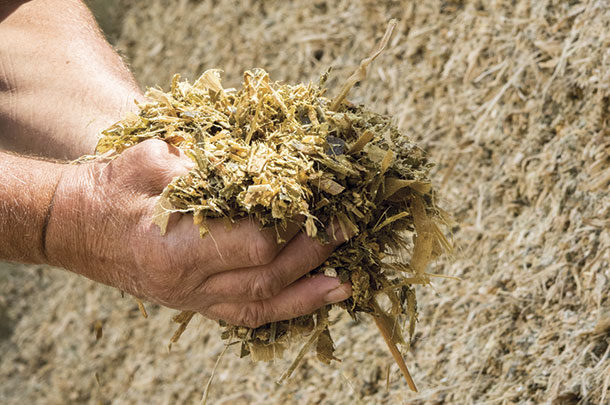Improvements in digestibility of starch and fiber increase the nutritive value of corn silage and thereby animal production. Alternatively, improvements in nutritive value of homegrown forages, such as corn silage, reduce purchased feed costs and generate more revenue.
The focus of this article is to provide an overview of the benefits of increasing fiber and starch digestibility in corn silage and to discuss selected alternatives to achieve it.
Benefits of improving fiber digestibility
Overall, ingested feed particles have to sink and reach a specific size threshold to leave the rumen. This particle reduction is achieved through chewing and digestion. Forages with greater fiber digestibility are more fragile and undergo this process of particle size reduction more efficiently. Thus, particles leave the rumen faster, allowing the animal to consume more feed.
Thus, greater fiber digestibility is associated with greater flow of particles leaving the rumen, increased consumption of dry matter (DM) and energy, and thus, improved milk production. In addition, the improvement in fiber digestibility promotes changes in chewing behavior patterns.
Several studies conducted across the U.S. indicate cows fed silage with more digestible fiber spend less time eating to consume similar or greater amounts of diet. Perhaps cows could use this extra time to rest and ruminate.
Which strategies improve fiber digestibility in silage?
Fibrous components in silage are cross-linked to lignin, which is indigestible and inhibits digestion of these components. The primary strategy to improve forage fiber digestibility would be to either decrease lignin content or its connection to other fibrous components. Many factors are known to affect the lignin content and bonding to other fiber fractions, including maturity at harvest, chop height and hybrid types.
Hybrid selection is a reliable strategy to increase fiber digestibility in corn silage. Brown mid-rib (BMR) hybrids, for example, have greater fiber digestibility than other hybrids. A review from the University of Wisconsin observed that cows fed BMR hybrids consumed 2 pounds per day more DM and produced 2.7 pounds per day more milk.
However, yield and nutritive value of hybrids varies from year to year and in different regions. Thus, analyzing hybrid performance trial results near your farm and across several years is crucial to select new hybrids for your herd.
In addition, the efficacy of specific management practices may vary when using different hybrids. For example, a study from Cornell University compared the use of greater cutting height on different hybrid types and observed benefits when harvesting leafy corn hybrids, but not for BMR hybrids.
Cutting height is another reliable strategy to reduce lignin in corn plants. Lignin is an important structural component concentrated in the bottom part of corn plants. As cutting height is increased, more lignin is left with the portion that remains in the field, and greater fiber digestibility is achieved. Results from a recent literature review from our group is in Table 1.

Briefly, DM yield is reduced as the row-crop head is raised. But decreased DM yields are offset by an increase in the milk per ton estimates at the higher cutting height. Greater milk estimate is a consequence of the greater fiber digestibility and starch concentration of the harvested material. This could possibly allow for greater quantities of high-cut silage to be included in the diet, rather than corn grain, providing an economic benefit through reduced purchased feed costs.
Because farm needs may vary in different years depending upon the yield and quality of the crop and existing on-farm inventories, team discussions among farmers, nutritionists and crop consultants are advised to determine individual farm priorities for maximum yield versus higher quality prior to the establishment of new cutting height guidelines.
Starch digestion and strategies to improve it
Starch digestion translates into energy supply for animals. Starch is fermented by rumen microorganisms into propionate, and propionate is later used as a precursor for glucose in the liver. If not digested in the rumen, starch reaches the small intestine and is digested by enzymes directly into glucose. Thus, digestible starch affects glucose (energy) supply and increases milk and milk protein yield by dairy cows.
Starch is located in the endosperm of corn kernels. However, the corn endosperm is surrounded by the pericarp, which is a hard structure that protects the endosperm and the embryo from external threats. Consequently, the breakdown of the pericarp to expose the starch endosperm is the primary goal to optimize starch digestibility in corn silage.
Perhaps this explains why kernel processing is one of the most important factors affecting starch digestibility in corn silage. It is well established that the use of kernel processors enhances kernel breakdown at harvest.
However, roll gap settings are a key player to obtain greater starch digestibility and corresponding milk production by dairy cows. A review from the University of Wisconsin reported that benefits of using a kernel processor is achieved only when rolls are set with gap settings between 1 to 3 millimeters (0.04 to 0.12 inches).
In addition, efficacy of kernel processing is reduced as maturity progresses. Kernel hardness increases as the plant matures, which in turn may cause kernels in very dry corn silage (i.e., mature) to be less susceptible to breakage.
The key to improve kernel processing is to have continuous monitoring of plant maturity within and across fields, proper roll gap settings, regular processor maintenance and continuous monitoring of kernel breakage during harvest.
Summary
Greater fiber digestibility increases intake, resting time and milk production by dairy cows. Alternatives to reduce lignin and its connection to other fibrous components are very likely the best options. Furthermore, greater starch digestibility increases energy supply and thus milk and milk protein yields by dairy cows. Kernel processing is the primary factor to enhance silage digestibility in corn silage.
However, other factors not discussed in this article, such as maturity at harvest and storage length, are also important and should be considered. Team discussions with nutritionists and crop consultants are advised prior to the establishment of these alternatives. ![]()
PHOTO: Silage cutting height and kernel processing are two key factors directly impacting milk production. Photo by Mike Dixon.

-
Luiz Ferraretto
- Assistant Professor of Livestock Nutrition
- Department of Animal Sciences
- University of Florida
- Email Luiz Ferraretto












